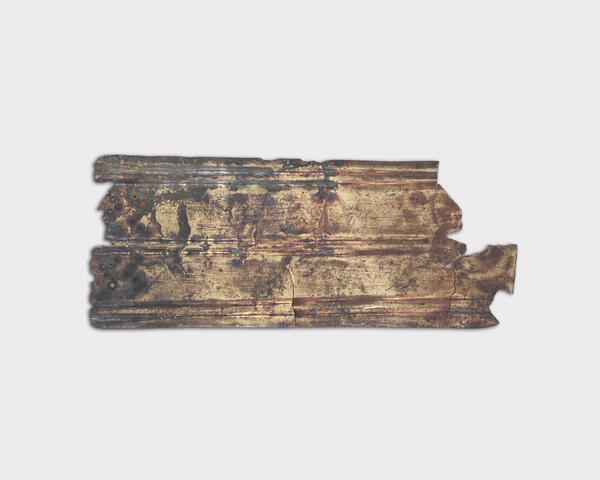The decoration from the museum’s collection was discovered as part of the Gaponovo hoard, found by local residents in 1994 near the northeastern outskirts of the village of Gaponovo in the Korenevsky district of the Kursk region. In 1996, the hoard was transferred to the collections of the Kursk Museum of Archaeology by the Left-Bank Early Slavic expedition of the Institute of Archaeology of the Russian Academy of Sciences. The brass sheet overlays are 0.3 millimeters thick. A linear decorative pattern can be seen on the surface, stamped from the reverse side of the item. On one edge of the plate, there are fine holes for the thread used to sew the plate onto a base.
The object is dated to the second half of the 7th century and belongs to the Kolochin archaeological culture. Similar to many other finds of ancient artifacts, this hoard was discovered by chance. The area housed a pioneer camp associated with the “Rubilnik” low-voltage devices factory. The hoard was found by local workers during the installation of a pipeline for the camp’s bathhouse. At that time, Elena Arkhipova, head of the laboratory for the Left-Bank Early Slavic Expedition of the Institute of Archaeology of the RAS, was on-site and documented the location of the find, collecting most of the items.
An archaeological trench was laid out at the work site and the study began. The treasure trove lay within the cultural layer, and, according to those who discovered it, the items formed a dense spindle-shaped cluster. A total of 488 items were uncovered.
The Gaponovo hoard is the seventeenth complex,
containing items from both women’s and men’s sets of adornments. Similar hoards
are known to exist in the area, including the forest-steppe and part of the
forest zone of the Dnieper region, and were first discovered in the late 19th
century. Due to the limited area of the excavation, it is difficult to
determine the exact timeframe of the items. Archaeologists date the ornaments
from the Gaponovo hoard to the mid-7th century. This dating is based on
analogous items that have the same timeframe in numismatic material.



